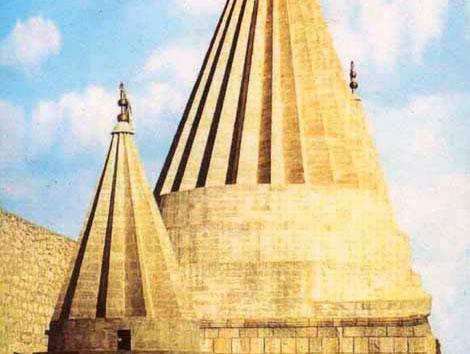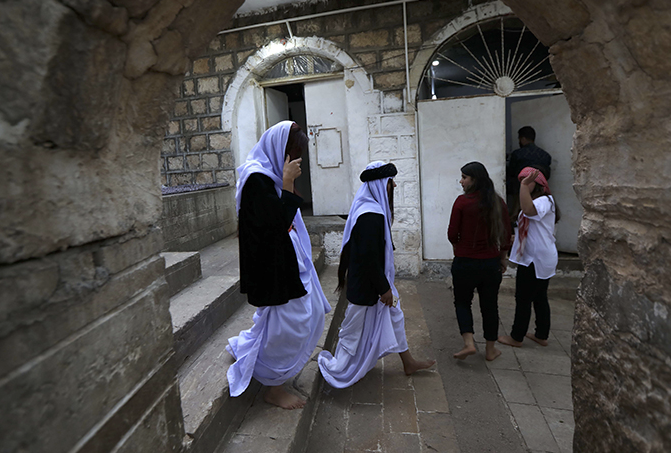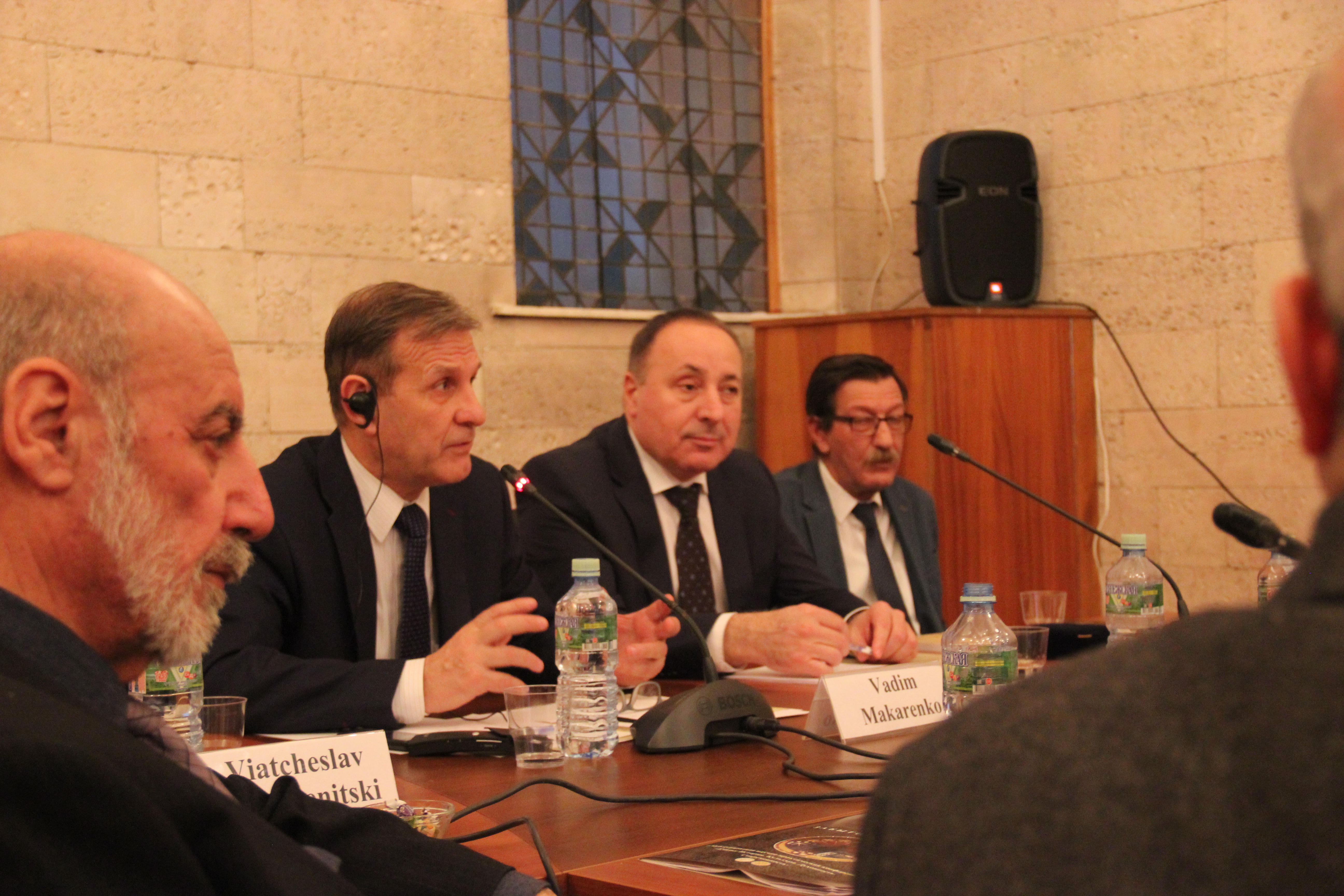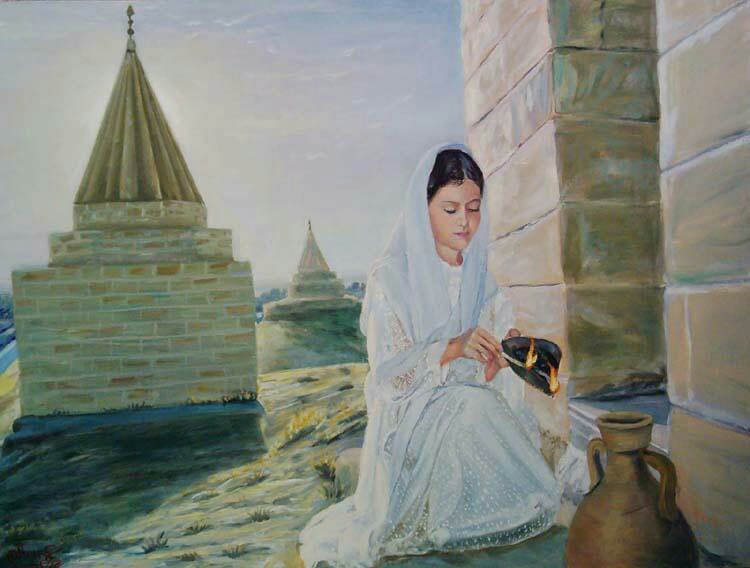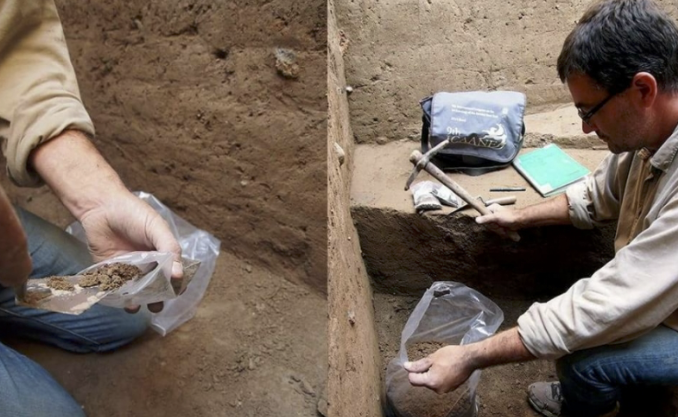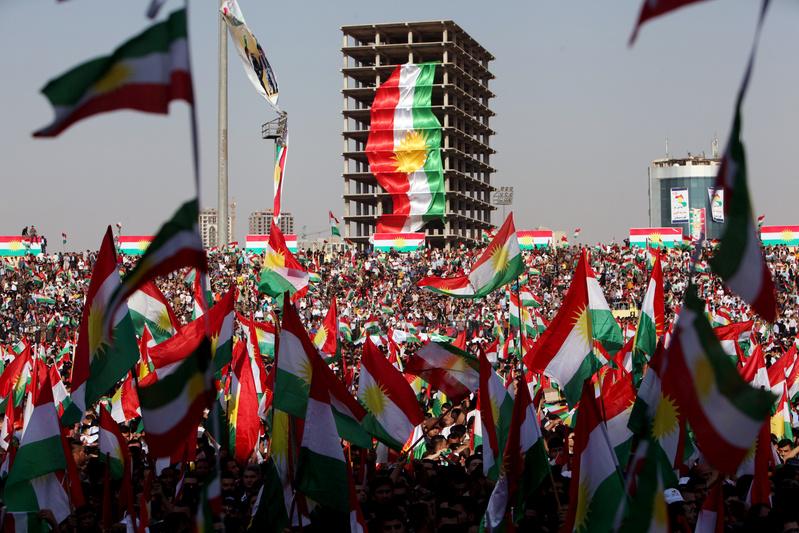It was a religion I had never heard of before 2007. During visits to Kurdistan in the north of Iraq that year, I met members of the religious sect the Yezidis (sometimes spelled Yazidis). Never having heard of the religion before, there was nothing obvious to physically distinguish them from among anyone else in the region, nothing to say, “This is a Yezidi, this is what marks him as different from other Kurds, whether Sunni or Shia Muslim, or Christian.”
While it was clear that they were discriminated against, other Kurds explained many people thought they were devil worshippers. Sometimes, this would come up in a joking manner. One time in a banquet hall the workers, all clearly friends, were introducing me to the one who was the Yezidi, calling him the devil worshipper among them as he broke into nervous laughter.
Of course, now with the current ISIS or Islamic State of Iraq and Syria (or Sham) crisis, in which Sunni extremists have conquered parts of Syria and northern Iraq, the Yezidis have come to the attention of the world.
The Yezidis trapped on Mount Sinjar, many dying of starvation until airdrops aided them, escaping ISIS, are among the main reasons the United States has sent troops back into Iraq. The ISIS forces have killed hundreds of Yezidis, along with Shias and Christians—really, anyone who does not want to follow their strict form of Islam.
Yet while the Yezidis are in the news because of this intense persecution and suffering, the horror of the images and the stories doesn’t really explain much about who the Yezidi people are. During a third visit to the country last year, while staying in a Yezidi-run hotel in Ain Kawa, a suburb of Erbil, the capital of the Kurdish Autonomous Region in the north of Iraq, I began to develop an understanding of the Yezidi people.
Ain Kawa is known as a Christian district, with Ziggurat-style churches dotting the horizon. It serves as home base for the United States Consulate and other foreign offices. With its countless bars and liquor shops, it’s the location of choice for most foreigners living in Erbil, famed for wild nightlife, a counter to what you might think living in Iraq entails.
The owners of the hotel where I stayed were Yezidis, eager to talk about their religion. The chatty desk worker said I would never be able to guess his religion, saying he wasn’t Muslim and he wasn’t Christian. “Well, you certainly can’t be Jewish, what are you?” I responded. It turned out almost the entire staff of the hotel was made of Yezidis.
The Yezidi religion predates Islam and Christianity, but incorporates certain components of Abrahamic faith. These are combined with aspects of the Zoroastrian religion, the ancient Persian faith still practiced in the region.
The staff showed me websites full of images from religious ceremonies, and most of all, the main Yezidi Temple Complex, in Lalish, a city about four hours from Erbil near the Kurdish border with Arab Iraq, close to Mosul. Even then, before the ISIS crisis, Mosul was a dangerous, disputed city with an insurgency movement.
I had seen pictures before of the Temple, with its conical towers set on top of a mountain. Its remote setting added to the exotic allure of its being the principal pilgrimage site for such an obscure religion.
The chance to visit Lalish came on an early September Friday. The most important day of the week for Yezidis from a religious perspective is a Wednesday. Friday, however, the most important day in Islam, runs a close second, and we would be assured of seeing many families at the temple.
When we arrived into Lalish, arches with symbols representing the sun indicated we were nearing the temple complex. It was a busy day, and my driver and translator Sardar parked the car far from the complex’s main entrance. We made our way up through a forested, hillside road, as hundreds of families said hello along the way, some curiously taking photos of me, a rare foreign visitor.
I was formally greeted by Luqman Mahmood, a Yezidi journalist who with his moustache, prominent cheekbones and slightly tousled hair resembled a Middle East version of Tom Selleck. Another community leader and writer, Khader Khalat, was with him. The two are behind the website www.lalishduhok.com, known as the Lalish Media Network, a news site which also has a tourism component, though it is only in Kurdish and Arabic. In English, a useful site about the religion is www.yeziditruth.org.
All the people around me were barefoot. Khader explained that it was tradition to take one’s shoes off when wandering the temple complex. “You will be at one with nature and you will feel if the land is hot or cold,” he said.
As a foreigner, I was welcome to break the rules and keep at least my socks on, but I wanted to experience Lalish as fully as possible. It was not easy to walk barefoot over rocky soil, many of the hard trodden patches searing in the direct light of the sun.
As we made our way to the main temple, Luqman and Khader spoke more about the Yezidi religion. They said that while it falls within the Abrahamic traditions, it predates all of its three main branches, and also incorporates Zoroastrian beliefs. The Yezidi calendar begins nearly a thousand years before the Hebrew one, making it among the world’s oldest continuing faiths.
The religion had gone through three main stages in its development:
1—before believing in God, they believed in nature and natural incidents
2—believing in God, after Abraham died. God is referred to as “Hoda,” which literally means he who makes himself
3 —period of Sheik Adi ibn Musafir, the main prophet of Yezidis. He had formalized the Yezidi religion into what it is today, and had settled Lalish, making it the center of the Yezidi religion. He died in the 12th century and his tomb is in the Lalish temple complex.
Luqman and Khader said that within the religion there are also seven angels and a belief in reincarnation. Among the angels is Tawuse Melek, who is often called the peacock angel. In explaining him, some Yezidis likened him to Lucifer, whom the main Abrahamic traditions regard as the devil.
However, Yezidis believe this angel did not fall from grace, and it is this difference in belief which has led to their persecution and accusations of devil worship. God is also the bringer of both good and bad to the world, another difference Luqman and Khader point out when compared to other Abrahamic faiths. Yet anyone familiar with the God of the Old Testament and the Torah who delights in constant destruction of humanity can see something akin in the Yezidi treatment of Him.
The two explained that Yezidism is a closed religion, meaning they do not accept converts. One can also not leave the religion. This led to one of the most horrific recent chapters in Yezidi history in 2007. When 17-year-old Du’a Khalil Aswad fell in love with a Muslim boy and was thought to have converted to Islam, she was murdered in a public “honor killing,” which was recorded on cellphones.
The incident is thought to have sparked a series of attacks against Yezidis, including the hijacking of a textile workers bus in Mosul in which more than 20 Yezidis were executed.
Luqman explained that since the instability created after the U.S. invasion of 2003, over 1,000 Yezidis had been murdered. This was even before the current ISIS crisis in which many more have perished.
There are nearly a million followers of the Yezidi religion throughout the world, with many now in Europe, primarily Germany. The Yezidis consider themselves ethnically Kurdish, the majority in areas surrounding Mosul, within Arab Iraq. It is these who are the most at risk, according to Luqman, but make up the vast majority of visitors at the temple the day of my visit. Indeed, the Yezidis who lived near Mosul are the ones who had to flee ISIS onto Sinjar mountain and are now taking refuge in Kurdistan.
The temple complex is a series of courtyards, some lined with walls and stairs leading to other structures. Near the entrance to one of the structures, I caught the attention of a multi-generational family, grandparents, parents and their children within a low alcove.
I was allowed to sit with them outside of an entry way on a padded stone bench, but I didn’t myself enter. All of them were barefoot, their clothing, especially that of the women and children, elaborate, the mother festooned in a silver beaded dress, her older daughters in red dresses with black vests, the youngest ones in white layered frilly concoctions, resembling Catholic communion dresses.
Luqman explained that there was a baptism for a newborn baby. The boys of the family were a complete contrast, running around in jeans and sweatpants, as if they had no concern for the special sacredness of the site. The bearded family patriarch was dressed in a radiant white dishdasha, or long robe, his head covered in a white ghutra or veil-like covering, a round, black igal holding it in place, a typically formal outfit for men in the Middle East.
Set on a mountaintop, the complex is layered, with platforms, walls, and other areas where people line up to watch those entering. The atmosphere was festive that day. Families were sitting picnic-style, meals of lamb and rice on large plates, scooped up with the flat bread nan. Candy and ice cream vendors waited near access points where the pathways meet. There was even a cotton candy machine that children gather around.
Luqman and Khader took me into a tightening series of courtyards. One was overgrown with trees, where young men rested in the shade. At its center was a monument, perhaps just over six feet high. It was shaped like the tops of parts of the temples around me: a conical pyramid-like roof, over a round base, at first reminding me of stone housetops in Italy’s Puglia region. But these cones are faceted. Luqman explained that they represented the sun shining down on Earth, facets mimicking rays of light.
There was an entryway near here to another courtyard, itself a prelude to the heart of the main temple. The courtyard was sunken, shaded by trees. From a balcony on one side, a few people looked down on us as we entered, waving hello. Older men and women made their way through the courtyard, stopping at what seemed to be sacred sites throughout: a grated opening in the ground, an open-air altar with niches for candles, blackened wax slickening its opening.
Finally, we came to the ornately carved temple portal itself, adorned with an image of a snake to its side. A turban-covered old man sat just inside the entryway, a small bowl for collecting change against the door jam. The snake was particularly kissed and touched as worshippers entered.
“You enter with your left foot first,” Luqman said, something which actually took some getting used to as I moved through various thresholds within the complex.
Through this entryway, we came into a broad long room, really a series of light-filled archways. The left side was draped in sheets of colorful fabric, most of it red and green. People tie the corners of it as a way of marking that they were here.
One of the most important rooms in the temple is the shrine of Sheik Adi ibn Musafir. He was a practitioner of Sufism, a particularly liberal, mystical form of Islam, and a sometime hermit who had moved to the Kurdish region seeking isolation from Baghdad during the 1100s, a time when that city was among the largest in the world. Yezidis believe Sheik Adi was the possible reincarnation of Tawuse Melek.
He formalized the religion, creating the priest system and closing the religion to outsiders so that there could be no new converts. His tomb is festooned with fabric, wrapped in green damask, balls of satiny fabric thrown over its top, sitting within a square, dark gray marble-lined room, topped with an enormous dome.
The ceiling was in bad shape, tiles coming off of it, and Khader talked of a restoration project under way. Though neither Khader nor Luqman knew the date of the room, the dome looks Ottoman era, perhaps from the 1600s, even if the temple complex’s origins must be from the 12th century, when the prophet had died.
In another chamber beyond this one, the atmosphere changed completely. It was dark, dank, the walls charcoal-colored, the feeling of a cave. The room was full of dozens of urns, each full of olive oil, used in some of the Yezidi rituals. A man stood at attention here to greet us, a giant ladle in hand as he moved the precious Mediterranean liquid between larger into smaller vessels.
Here Luqman also pointed out a curious structure, a mound rising on the side of the wall in front of all the urns. Yezidis play a sort of basketball game here, balling cloth up and tossing it onto the top of the mound.
In another chamber there was a hole inside of a ledge we put our hands through. It’s nothing at all like it, but it made me think of Church of the Nativity in Bethlehem, and its silver-encased hole where visitors line up to touch where legend states Jesus was born.
We headed out soon after, back into the sunlight-dappled gardens of the temple complex, to join worshippers picnicking. There’s even a special visitor among them: Sheik Shamu, a political candidate for office doing a pressing of the hands.
“There are people who come to write wrong things,” Luqman said of some journalists. “We don’t want extra than the truth. Only the truth. We just want them to talk the truth, only the reality.” In Kurdistan, Luqman said he felt safe, but that for others living in and around Mosul, the creeping feeling that everything can be taken away from them hovers at every moment, with land seizures, bombings of Yezidi villages, and discrimination in employment.
During the visit, it was hard to get a sense of why the Yezidis are persecuted. One simply sees families enjoying the day out, making sure a foreigner feels welcome. Would you necessarily get a sense of the thousands of years of persecution Jews have suffered from a few hours in a synagogue, or an understanding of the violence that tore Europe apart during the Reformation seeing a ceremony inside of a Protestant church?
My visit could not make me fully understand all the aspects of the Yezidi religion but it was clear the practitioners felt misunderstood and persecuted within their Middle East homeland. If this was not in high relief while I was in Iraq seeing the Lalish temple complex, the current ISIS crisis has made that abundantly so. It’s been nothing short of a genocide for them.
Speaking by phone in recent days, Luqman said there are still Yezidis trapped on the Sinjar mountain, and that babies have died in their mothers’ arms from lack of milk to drink. He also said more than 450 families were at the temple on a recent Friday, continuing to practice their faith in spite of all the adversity.
The tragedy is that it is only with the murderous attacks on the adherents of this unusual religion that the Western world has come to know the Yezidis, the people who call this beautiful mountaintop temple complex in Lalish their spiritual home.
Leaving the complex that September Friday, Luqman told me, “Tourists and foreigners are welcome anytime. Yezidi people love when foreigners come here. We want to you to take the message of us to your home.”
With tourism in Kurdistan still something for the adventurous, very few foreigners will ever likely see the remote temple complex here in Lalish. However, letting the world know of the reality of life for those who follow this obscure religion may be one of the key ways to ensure it survives its current, appalling crisis.

